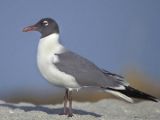A study made by a team at University of Georgia have found that wood duck and laughing gull (photos) are very susceptible to the highly pathogenic H5N1 bird flu virus and has the potential of transmitting the disease.
Different bird species of North America would have various responses to the infection with this virus. This knowledge is vital to quickly detect the disease should it arrive in North America. "If you're looking for highly pathogenic H5N1 in wild birds, it would really pay to investigate any wood duck deaths because they seem to be highly susceptible, as are laughing gulls," said David Stallknecht, a member of the UGA Biomedical and Health Sciences Institute.
"It was also very interesting that in some species that you normally think of as influenza reservoirs - the mallard, for instance - the duration and extent of viral shedding is relatively low. This may be good news since it suggests that highly pathogenic H5N1 may have a difficult time surviving in North American wild birds even if it did arrive here."
In an airtight biosecurity lab at the USDA Agricultural Research Service's Southeast Poultry Research Laboratory, the team determined the virus amount shed in the feces and through the respiratory system of several wild bird species.
"We chose birds that, because of their behavior or habitat utilization, are most likely to transmit the virus or bring the virus here to North America," said doctoral student Justin Brown.
The species were: mallard (often infected with commonly low-pathogenic viruses in North America and Eurasia); Northern pintail and blue-winged teal (with long migrating routes between continents); redhead and wood duck (which breed over extensive area in U.S.).
The laughing gull is a common coast bird at the Atlantic. Low-pathogenic viruses are mostly eliminated through feces and other birds get contaminated by drinking infested water. The team found that - in highly pathogenic H5N1 - however, is spread mostly through the respiratory tract.
The virus is easier to detect investigating mouths and respiratory tracts. "Doing avian influenza surveillance is pretty tricky because there are a lot of species differences and there are also seasonal differences," he said.
"So you've got to pick the right species at the right time and you've got to collect the right samples."
In a parallel study, the team found that H5N1 virus persists much less in the water than common low-pathogenicity viruses, even by more than 70%. This could impede the establishment of this virus in North America. Currently, the team is assessing the minimum amount of virus necessary to infect a bird.

 14 DAY TRIAL //
14 DAY TRIAL // 
